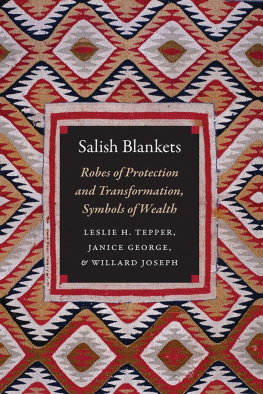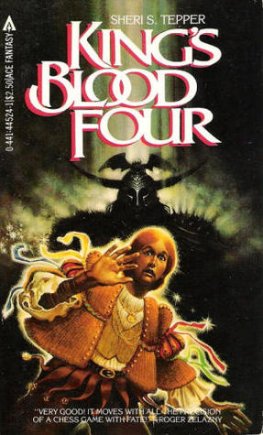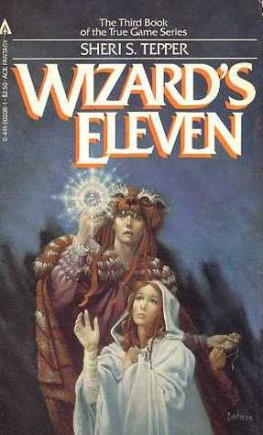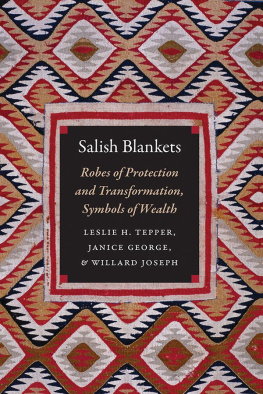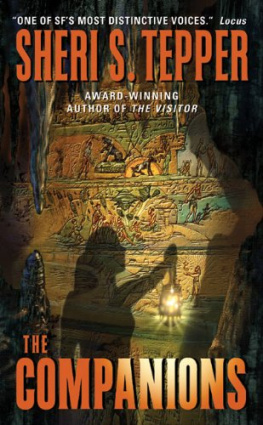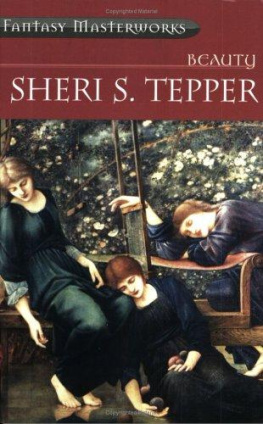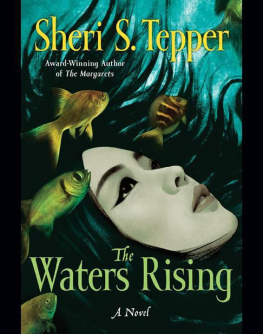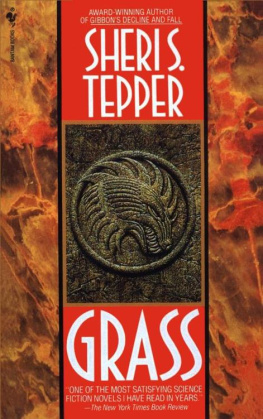Leslie H. Tepper - Salish Blankets
Here you can read online Leslie H. Tepper - Salish Blankets full text of the book (entire story) in english for free. Download pdf and epub, get meaning, cover and reviews about this ebook. year: 2017, publisher: University of Nebraska Press, genre: Home and family. Description of the work, (preface) as well as reviews are available. Best literature library LitArk.com created for fans of good reading and offers a wide selection of genres:
Romance novel
Science fiction
Adventure
Detective
Science
History
Home and family
Prose
Art
Politics
Computer
Non-fiction
Religion
Business
Children
Humor
Choose a favorite category and find really read worthwhile books. Enjoy immersion in the world of imagination, feel the emotions of the characters or learn something new for yourself, make an fascinating discovery.
- Book:Salish Blankets
- Author:
- Publisher:University of Nebraska Press
- Genre:
- Year:2017
- Rating:3 / 5
- Favourites:Add to favourites
- Your mark:
- 60
- 1
- 2
- 3
- 4
- 5
Salish Blankets: summary, description and annotation
We offer to read an annotation, description, summary or preface (depends on what the author of the book "Salish Blankets" wrote himself). If you haven't found the necessary information about the book — write in the comments, we will try to find it.
Salish Blankets — read online for free the complete book (whole text) full work
Below is the text of the book, divided by pages. System saving the place of the last page read, allows you to conveniently read the book "Salish Blankets" online for free, without having to search again every time where you left off. Put a bookmark, and you can go to the page where you finished reading at any time.
Font size:
Interval:
Bookmark:
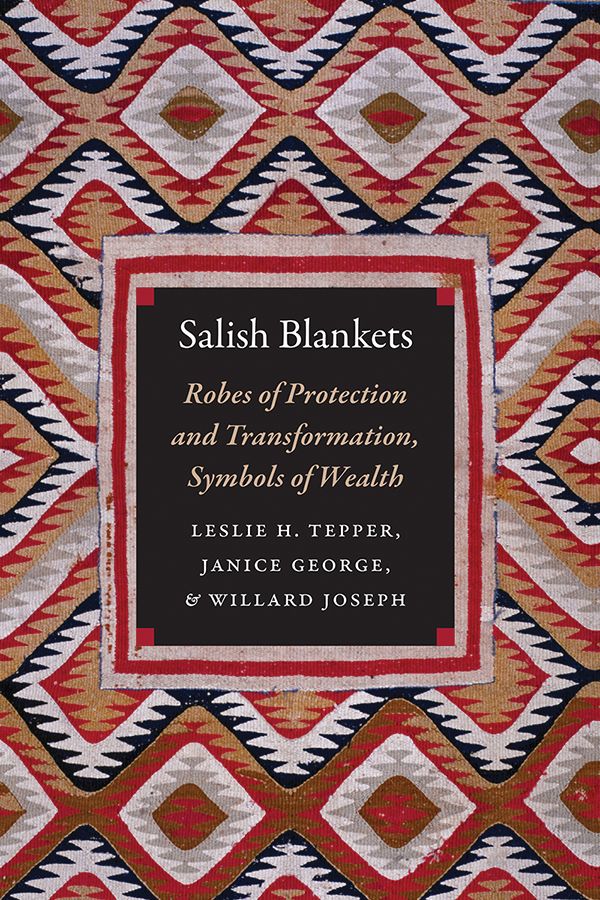
This book does so many things well.... The sensitive and intelligent discussion reveals the difficulties of research and interpretation of an art form that was changing and in flux for many generations.... The authors have nimbly stitched together the fragments to create a whole.
Barbara Brotherton, curator of Native American art at the Seattle Art Museum
These three authors have thought of us and those yet to come... so this ancient/contemporary craft and art may be understood and continued in a modern world.
annie ross, Indigenous weaver and associate professor in the Department of First Nations Studies at Simon Fraser University
Leslie H. Tepper, Janice George (Chepximiya Siyam), and Willard Joseph (Skwetsimltexw)
University of Nebraska Press | Lincoln & London
2017 by the Board of Regents of the University of Nebraska
Cover designed by University of Nebraska Press; cover image is from the interior.
Author photo courtesy of Miriam Tepper.
All rights reserved
Publication of this volume was financially assisted by the Canadian Museum of History (historymuseum.ca).
Library of Congress Cataloging-in-Publication Data
Names: Tepper, Leslie Heyman, 1947 author. | George, Janice, author. | Joseph, Willard, author.
Title: Salish blankets: robes of protection and transformation, symbols of wealth / Leslie H. Tepper, Janice George (Chepximiya Siyam), and Willard Joseph (Skwetsimltexw).
Description: Lincoln NE : University of Nebraska Press, [2017] | Includes bibliographical references and index.
Identifiers: LCCN 2016048676 (print)
LCCN 2016049461 (ebook)
ISBN 9780803296923 (pbk.: alk. paper)
ISBN 9781496201478 (epub)
ISBN 9781496201485 (mobi)
ISBN 9781496201492 (pdf)
Subjects: LCSH : Coast Salish IndiansMaterial culture. | Indian blanketsNorthwest, Pacific. | Indian textile fabricsNorthwest, Pacific. | Hand weavingNorthwest, Pacific.
Classification: LCC E 99. S 21 T 45 2017 (print) | LCC E 99. S 21 (ebook) | DDC 677/.028242dc23
LC record available at https://lccn.loc.gov/2016048676
The publisher does not have any control over and does not assume any responsibility for author or third-party websites or their content.
The authors are grateful to the Elders and cultural leaders from Salish communities who have supported and encouraged this project. They have been important advisors to us over the years. Weaving, we were told, is a key element of Salish traditional culture, and the teachings surrounding it should not be lost. The way to keep culture alive, they said, is to share it, experience it, and record peoples knowledgeboth of the historical teachings and of the contemporary activities. The privacy associated with particular sacred and ritual traditions has been respected in the research and the writing of this book. We have been careful to present only those materials and information that would have been, or are currently, used for family-related or community and public ceremonies.
We would like to thank the research and collections staff at the Perth Museum and Art Gallery, the Pitt Rivers Museum of the University of Oxford, the Royal British Columbia Museum, the Smithsonian Institutions National Museum of Natural History and National Museum of the American Indian, the American Museum of Natural History, the Peabody Museum of Harvard University, the Burke Museum of the University of Washington, the Museum of Vancouver, the British Museum, the Museum of Anthropology of the University of British Columbia, and the Canadian Museum of History. Their gracious welcome into the storerooms and their enthusiasm in sharing ideas, documentation, and artifacts made this project truly a joint effort with our museum colleagues.
We gratefully acknowledge the support of the Canadian Museum of History. From our initial proposal for this study, the museum has allocated curatorial time for research and writing, provided travel funding that allowed us to analyze Salish weaving collections, and offered financial and administrative assistance when the manuscript was accepted for publication. The encouragement and interest of the chiefs of the Ethnology Department and of the Research Division over the years have carried this project steadily forward. We would like to thank the staff at the University of Nebraska Press, particularly Matthew Bokovoy, for their guidance in bringing the manuscript to publication.
The authors are all weavers, though from different traditions. We have experienced the excitement of thinking about a new project; the pleasure of choosing colors, textures, and design; and the satisfaction in taking a finished textile off the loom. Weavers form a strong community. We are indebted to the people who taught us the joy of weaving, to our families and friends, and to the many people who have shared their insights, experiences, and expertise.
You should think about blankets as merged objects. They are alive because they exist in the spirit world. They are the animal. They are part of the hunter; they are part of the weaver; they are part of the wearer.
Chief Janice George, Squamish
The Salish blanket, worn as a ceremonial robe, is an object of extraordinary complexity. Said to exist in the supernatural realm, these robes are made manifest in the natural world through Ancestral guidance. Wearing a woven blanket during ritual is transformative, moving the individual from the domain of the mundane to a sacred space. They are protective garments that at times of great changes in a persons lifecelebrating a birth, participating in a marriage, mourning a deathoffer emotional strength. A well-made blanket can raise the owners prestige in the community and demonstrate a weavers technical expertise along with her finely honed artistic vision.
A shared interest in Salish weaving brought the authors together, and for several years we have researched, traveled, discussed, and collaborated in order to gain a better understanding of these fascinating textiles. We studied fabrics in museum collections in Canada, the United States, and Great Britain. Libraries were searched for publications and archives were examined for relevant entries in diaries and records kept by explorers and fur traders. Historical photographs and audiovisual materials added valuable information. We spoke with Elders, interviewed weavers, and organized and attended workshops. During this time, information and expertise were shared in conversations among the three authors, with participants at textile conferences and gatherings, and with museum registrars, curators, and conservators. We explored ideas about the historical and contemporary role of Salish blankets and the importance of weavers in the community. Continually questioning our assumptions, we gradually began to perceive Salish textiles in new ways.
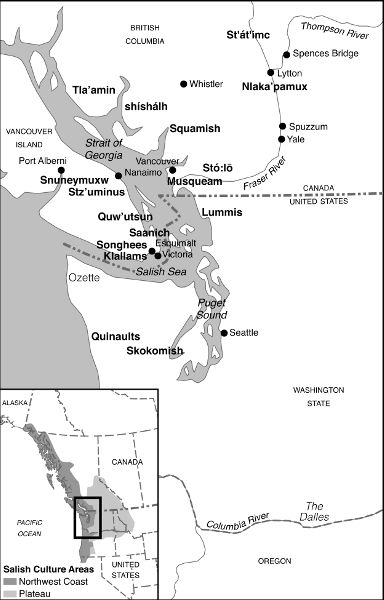
Selected Salish First Nations. Courtesy of the Canadian Museum of History, mapmaker Franois Goulet.
Our partnership began in 2005 when we organized a workshop at the Canadian Museum of Civilization, now named the Canadian Museum of History ( CMH ). Salish weavers from several communities near the city of Vancouver and from Vancouver Island were invited to come to the national capital to research the collections. They shared experiences and discussed topics of mutual interest. It includes videos showing how to warp a loom and how to weave using twill and twine techniques. Blueprints for building a tabletop loom, ideas for community weaving activities, and supportive comments from Elders provide guidance to new weavers. It also offers online links to museum databases, a bibliography, and a list of archival images. The CD-ROM has been used by Salish teachers and students in schools, cultural centers, workshops, and Elders gatherings.
Font size:
Interval:
Bookmark:
Similar books «Salish Blankets»
Look at similar books to Salish Blankets. We have selected literature similar in name and meaning in the hope of providing readers with more options to find new, interesting, not yet read works.
Discussion, reviews of the book Salish Blankets and just readers' own opinions. Leave your comments, write what you think about the work, its meaning or the main characters. Specify what exactly you liked and what you didn't like, and why you think so.

